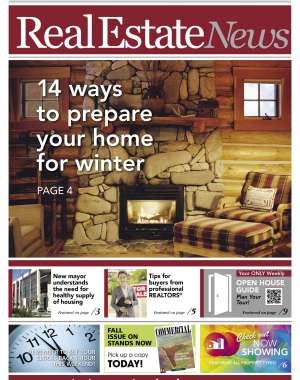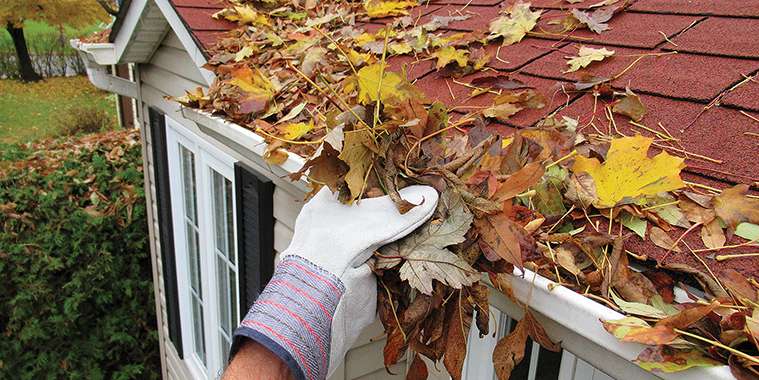Summer’s warmth is now a fading memory and the inescapable and important task of winterizing your home before the first big freeze looms. Luckily, we’ve created a checklist of the many things to accomplish before that first snowfall.
1. Garden hoses
Disconnect any garden hoses, drain them of any residual water and store them away somewhere dry, protected from the weather.
Why? Garden hoses can become stiff and crack during the winter if left outside. Water in the tubing can freeze and expand, causing your hose to split and forcing you to replace it in the spring.
2. Outdoor taps
Turn off all valves inside the house, then open the taps outside to drain excess water. Be sure to leave the outdoor valves open through the winter.
Why? When water sits in the pipe feeding the outside tap, freezing temperatures can conduct along the pipe to create ice inside the pipes. This can cause cracks and damage the pipe’s joints and valves, resulting in bursts and flooding.
3. Fireplace chimney
Sweep your chimney to remove any creosote buildup and ensure a clear airway for smoke and particles to exit the chimney. This may require the services of a professional chimney sweep.
Why? Because blockages can cause smoke to backdraft into the home and creosote buildup will ignite under certain conditions, causing devastating chimney fires. Have your chimney cleaned and inspected annually by a certified professional before you use it for the season as some insurance policies require this.
4. Gas grill or barbecue
Clean the interior of your grill and all its internal parts. Coat the metal parts of your burner in cooking oil. Store outdoors with a sturdy cover or wrapped in heavy plastic if stored in a garage or shed.
Why? Cleaning the grill prevents mould and using cooking oil prevents oxidation of your burner elements, while covering protects it from the elements. Wrapping your barbecue in plastic for indoor storage helps keep critters from nesting inside.
5. Air conditioners
Turn off the power to any external AC unit and cover it. Now is also the time to remove any window or portable units, clean their air filters and store them for the season.
Why? Shutting off the power to external ACs prevents phantom power — the little bit of heat generated by running power to the unit. You can cover your unit with a piece of plywood and a rock to hold it down, or be sure to use a specially-made cover that will wrap the unit tightly and not a tarp or other loose-fitting option that can create damaging moisture build-up. Removing window and portable ACs will help insulate your home against drafts, lowering utility costs.
6. Furnace
Have your furnace inspected and serviced by a certified HVAC technician. It is advised to do this annually.
Why? This ensures your furnace is working optimally, preventing inconvenient breakdowns during winter.
7. Furnace filter
Replace your furnace filter, then set reminders to replace the filter as needed (check monthly).
Why? Furnace filters remove dust, dirt and allergens from the air in your home. Replacing the filter also enables your furnace to operate more efficiently.
8. Gutters and eavestroughs
Once the trees around your home have shed their foliage, clean all leaves, twigs and debris out of your eavestroughs to ensure clear passage down the gutters.
Why? Clogged eavestroughing and gutters cause ice dams which apply unnecessary pressure and stress along the edge of your roof. This can lead to water incursions, as well as an excess of water close to your home when the snow on your roof thaws and runs off.
9. Windows and doors
Install weather stripping around your doors and windows, removing any old material if not done annually. For older windows, applying shrink-wrap plastic can also help reduce drafts. Door sweeps placed on the bottom of doors cuts down on heat loss.
Why? Heat is lost through spaces around doors and windows. Applying this stripping will help prevent drafts and reduce heating costs.
10. Program your thermostat
If you have a programmable thermostat, now is the time to set your temperatures for the winter to save on heating costs. Now is also the time to check your thermostat’s batteries and change them if needed.
Why? When you turn your thermostat up, you’re not just heating the air in your home, it takes energy to heat the objects in your house, too. If you’re planning to be away for an extended period, or while you’re sleeping, it makes sense to lower your home’s temperature but otherwise, it’s often more cost effective to set the temperature in your home and leave it there.
11. Smoke and carbon monoxide alarms
Test your carbon monoxide and smoke detectors and replace the batteries with new ones.
Why? These are life-saving devices and should always have fresh batteries. Used batteries can be repurposed as backups for alarm clocks or electronics.
12. Lawn mower
Clean and service the engine of your lawn mower and remove any grass or mulch buildup underneath. Empty the gas tank or add a stabilizer and sharpen the blades before storing it in a dry, protected place for the winter.
Why? Like any machine, regular maintenance will help extend its life and ensure it will be ready to go in the spring.
13. Pest prevention
Ensure any possible entries into the home — spaces in the siding, under the eaves and vent openings — are sealed or adequately protected.
Why? Mice, chipmunks, squirrels and racoons will want to burrow in the warmest and safest place they can find for the winter. Keeping them out of your home will save you frustration and money resulting from any damage they might cause.
14. Insulation
Check the insulation in your attic to ensure it hasn’t sagged and confirm its “R” value. R value indicates the insulating power and its ability to resist heat loss. The higher the R rating, the lower the heat loss will be.
Why? Certain types of insulation (like fibreglass batting) can sag over time, reducing its effectiveness and allowing more heat to escape. Conversely, in the summer, the insulation in your attic is the barrier to keep the hot air from affecting the temperature in your home.
Winterizing your home may require a couple of weekends to complete, but taking these steps to secure your home before the cold weather hits will not only help save you money, it will allow for many more—warm and comfortable—years of enjoyment.
— Realtor.ca



